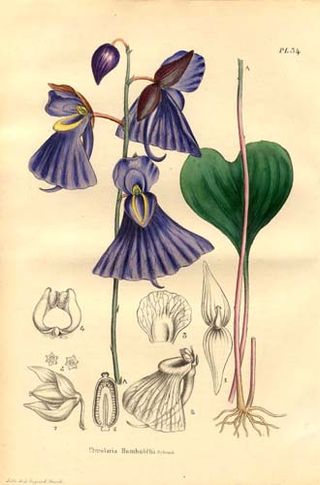
Utricularia humboldtii is a large perennial carnivorous plant that belongs to the genus Utricularia. Peter Taylor lists it as either an "aquatic-epiphyte", a subaquatic or a terrestrial species. U. humboldtii is endemic to South America, where it is found in Brazil, Guyana, and Venezuela. It was originally published and described by Robert Hermann Schomburgk in 1840. It is usually found growing in the water-filled leaf axils of some species of bromeliad, including Brocchinia micrantha, B. tatei, and B. reducta and also plants in the genus Orectanthe. It also grows as an epiphyte on tree trunks or as a subaquatic or terrestrial species in shallow water or wet soil in open savanna. It is found mostly between altitudes of 1,200 m (3,937 ft) and 2,500 m (8,202 ft), though it has been found at altitudes as low as 300 m (984 ft). It has been collected in flower throughout every month of the year.
Utricularia podadena is a small, probably perennial, terrestrial carnivorous plant that belongs to the genus Utricularia and is the only member of Utricularia sect. Candollea. U. podadena is endemic to Malawi and Mozambique, being known only from the type location in Malawi and from one other collection in Mozambique. As of Peter Taylor's 1989 monograph on the genus, more recent efforts to locate this species have failed. It was originally published and described by Taylor in 1964 and placed in its own section, Candollea, in 1986. It grows as a terrestrial plant in marshy grasslands in the presence of Loudetia species at altitudes of around 1,000 m (3,281 ft). It flowers in July. It is a very distinct plant in the genus with the long stipitate glandular trichomes covering the flower. Its affinities within the genus are not clear.
Utricularia hirta is a small, probably perennial, terrestrial carnivorous plant that belongs to the genus Utricularia. U. hirta is native to India and Southeast Asia, where it can be found in Bangladesh, Cambodia, Laos, Sri Lanka, Thailand, and Vietnam and on the island of Borneo. It was originally named by Jacob Theodor Klein and formally described and published by Johann Heinrich Friedrich Link in 1820. It grows as a terrestrial plant in damp or wet open areas or marshes at altitudes from sea level to 1,000 m (3,281 ft). It has been collected in flower between July and December.
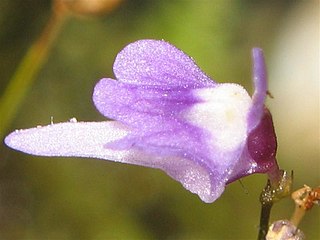
Utricularia minutissima is a small or very small terrestrial carnivorous plant that belongs to the genus Utricularia. U. minutissima is native to Asia and Australia. Among the islands of Southeast Asia, it is found on Borneo, New Guinea, and Sumatra.
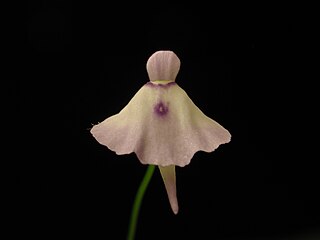
Utricularia pubescens is a small to medium-sized, probably annual, terrestrial or lithophytic carnivorous plant that belongs to the genus Utricularia and is the only member of Utricularia sect. Lloydia. U. pubescens is native to India, tropical Africa, and Central and South America. It was originally published and described by James Edward Smith in 1819 and placed in its own section, Lloydia, by Peter Taylor in 1986. It grows as a terrestrial or lithophytic plant in boggy grasslands in damp peaty soils at altitudes from sea level to 1,900 m (6,234 ft). This species possesses small peltate leaves, which are diagnostic for this species in the genus.
Utricularia fimbriata is a small to medium-sized, probably perennial carnivorous plant that belongs to the genus Utricularia. U. fimbriata is endemic to Colombia and Venezuela. It grows as a terrestrial plant in damp, sandy soils in savannas at altitudes from near sea level to 300 m (984 ft). It was originally described and published by Carl Sigismund Kunth in 1818. In 1913, John Hendley Barnhart treated this species as part of a new genus, Aranella, which was later reduced to the taxonomic rank of section within the genus Utricularia, thus bringing the species back to the original genus.

Utricularia bifida is a small annual carnivorous plant that belongs to the genus Utricularia. It is native to Asia and Oceania and can be found in Australia, Bangladesh, Burma, Cambodia, China, Guam, India, Indonesia, Japan, Korea, Laos, Malaysia, Nepal, New Guinea, Palau, the Philippines, Sri Lanka, Thailand, and Vietnam. U. bifida grows as a terrestrial plant in damp soils and in rice fields. It was originally described and published by Carl Linnaeus in 1753.
Utricularia bosminifera is a small, probably perennial, carnivorous plant that belongs to the genus Utricularia. It is endemic to the Ko Chang island of Trat Province in Thailand. U. bosminifera grows as a terrestrial or subaquatic plant on sandy banks by streams. It flowers throughout the year. U. bosminifera was originally described and published by Carl Hansen Ostenfeld in 1906 and later reduced to a variety of U. bifida by J. F. Maxwell in 1985. Peter Taylor disagreed with Maxwell's taxonomic treatment and reinstated the species in his 1986 monograph. The species epithet, bosminifera, refers to the bladder traps' shape, which resembles a Bosmina, a small crustacean.

Utricularia delphinioides is a small to medium-sized, probably perennial, carnivorous plant that belongs to the genus Utricularia. It is endemic to Indochina and can be found in Cambodia, Laos, Thailand, and Vietnam. U. delphinioides grows as a terrestrial plant in swamps and rice fields, wet grasslands, or open pine forests at altitudes from near sea level to 1,300 m (4,265 ft). It was originally named by Clovis Thorel but formally described and published by François Pellegrin in 1920. A variety, U. delphinioides var. minor, was also described in 1920, but Peter Taylor reduced the variety to synonymy under U. delphinioides because he discovered a continuous range of sizes between the larger and smaller forms, size being the only distinctive characteristic in the 1920 description of the variety.
Utricularia foveolata is a small, probably annual, carnivorous plant that belongs to the genus Utricularia. It is native to the Old World tropics, where it can be found in Africa, Asia, Australia, and on the eastern end of Java. U. foveolata grows as a terrestrial or subaquatic plant in wet soils or in shallow water, sometimes as a weed in rice fields in Asia. It was originally described and published by Michael Pakenham Edgeworth in 1847.
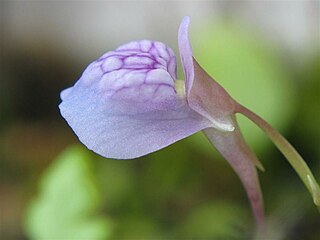
Utricularia graminifolia is a small perennial carnivorous plant that belongs to the genus Utricularia. It is native to Asia, where it can be found in Burma, China, India, Sri Lanka, and Thailand. U. graminifolia grows as a terrestrial or affixed subaquatic plant in wet soils or in marshes, usually at lower altitudes but ascending to 1,500 m (4,921 ft) in Burma. It was originally described and published by Martin Vahl in 1804. It has also recently been grown in planted aquaria. It is however not a true aquatic species, as seen in species from Utricularia subg. Utricularia.

Utricularia involvens is a medium-sized, probably perennial, carnivorous plant that belongs to the genus Utricularia. It grows naturally in southeastern Asia and northern Australia. U. involvens grows as a terrestrial plant in wet grasslands or open vegetation, usually at low altitudes but ascending to 900 m (2,953 ft) in Malaysia. It was originally described and published by Henry Nicholas Ridley in 1895.
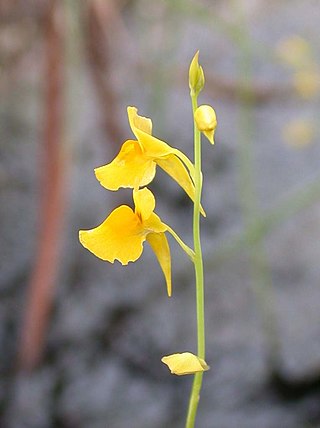
Utricularia odorata is a medium-sized, probably perennial carnivorous plant that belongs to the genus Utricularia. It is native to southeastern Asia and northern Australia. U. odorata grows as a terrestrial plant in wet grasslands at low altitudes. It was originally described by François Pellegrin in 1920. The specific epithet odorata is derived from reports that the flowers are fragrant.
Utricularia pierrei is a medium-sized, probably perennial carnivorous plant that belongs to the genus Utricularia. It is native to Indochina and can be found in Thailand and southern Vietnam. U. pierrei grows as a terrestrial plant at altitudes around 1,500 m (4,921 ft). It was originally described by François Pellegrin in 1920 in honor of the original collector of the species.

Utricularia scandens is a small, probably annual carnivorous plant that belongs to the genus Utricularia. It has a wide native distribution that includes Africa and Asia. U. scandens grows as a terrestrial plant in wet grasslands and bogs at lower altitudes around sea level up to 2,300 m (7,546 ft). It was originally described by Ludwig Benjamin in 1847. There is a significant amount of synonymy established for this species, in part because of its large distribution and variable morphology.

Utricularia uliginosa, the Asian bladderwort, is a small annual carnivorous plant that belongs to the genus Utricularia. It is native to Southeast Asia, Oceania, and Australia. U. uliginosa grows as a terrestrial or subaquatic plant in seasonally flooded shallow pools with sandy soils or on banks and among rocky stream beds at low altitudes. It was originally described by Martin Vahl in 1804.
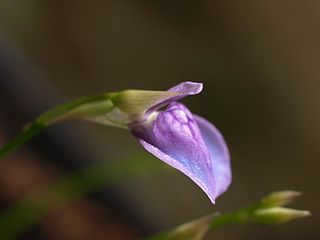
Utricularia babui is a perennial carnivorous plant that belongs to the genus Utricularia. It is native to India and had only been collected from the Kolhapur district at the time of its description in 2005. U. babui grows as a terrestrial plant in and near small streams in open forests at altitudes from 700 m (2,297 ft) to 900 m (2,953 ft). Specimens of U. babui were previously mistaken for U. graminifolia. It was originally described and published by Shrirang Ramchandra Yadav, M. M. Sardesai, and S. P. Gaikwad in 2005.

The Journal of Insectivorous Plant Society is a quarterly Japanese-language periodical and the official publication of the Insectivorous Plant Society of Japan. The journal was established in January 1950. As of 2010, it was published in A4 format and totals around 120 pages annually. The English title has been used alongside the original Japanese one from the April 1986 issue onwards.
Utricularia inthanonensis is a terrestrial lithophytic carnivorous plant that belongs to the genus Utricularia. It is endemic to northern Thailand in Doi Inthanon National Park where it is only known from the type locality. It grows on moist granite rocks at altitudes around 1,650 m (5,413 ft). It is closely related to U. garrettii, another species endemic to Thailand, and differs from it in corolla, seed, and bladder morphology. Utricularia inthanonensis can also be found growing with U. striatula. It was first formally described by Piyakaset Suksathan and John Adrian Naicker Parnell in 2010 from collections made by Suksathan in 2005 and 2007.
Utricularia phusoidaoensis is a terrestrial lithophytic carnivorous plant that belongs to the genus Utricularia. It is endemic to the northern Thailand province of Phitsanulok on Phu Soi Dao, where it is only known from the type locality. It grows on wet cliffs at altitudes around 2,000 m (6,562 ft). It is related to U. garrettii, another species endemic to Thailand that shares a similar seed morphology. Utricularia phusoidaoensis is easily distinguished by its purple 4-6-lobed corolla, reniform leaves, and the staghorn-like trap appendages. It has been found growing in the presence of U. spinomarginata. It was first formally described by Piyakaset Suksathan and John Adrian Naicker Parnell in 2010 from collections made by Suksathan in 2007.











